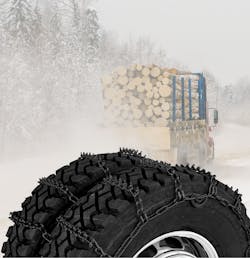Kinedyne redesigns Grip Link Tire Chains
In recent years, many commercial truck tires have evolved to include a broader surface face and extra-deep treads. To provide customers with maximum traction when driving in slippery conditions on these tires, Kinedyne has redesigned its Grip Link tire chains to include additional links on the side chains as well as more cross chains.
The upgraded highway Grip Link Tire Chains are designed to provide excellent traction on roads and highways covered in ice and snow, while the 7mm and 8mm off-road Grip Link Tire Chains are designed for uneven, bumpy terrain, and through difficult environments such as forest floors, and the scree, sand, and mud of a construction site, quarry, or mine.
“Our new Grip Link highway and off-road chains ensure that there are no fitment issues and improves safety when traveling in winter weather,” said Robert Spooner, director of sales – Canada for Kinedyne.
Grip Link Highway Tire Chains come in 7mm steel wire V-bar and square link designs and are available for tire sizes of 11 by 22.5 and 11 by 24.5 in both singles and dual-triples styles. The 11 by 22.5 singles come with 14 cross chains per set, while the dual-triple version come with 28. The 11 by 24.5 singles come with 15 cross chains with the dual-triple version coming with 30. All Kinedyne Grip Link Highway Tire Chains are equipped with four outside cams, providing even tension and an additional 1.3” each of tightening tension.
The V-shaped bars on the V-bar tire chains act as miniature icepicks that pierce the ice, propelling the tire forward even over a slippery surface. The corners of the square-shape links on the square link tire chains are engineered to dig into the ice and snow and designed to cover more surface area, thus helping maintain a better grip on the highway.
Kinedyne’s Off-Road Grip Link Stud Tire Chains are designed to dig into the ground, creating a solid anchor that pushes the tire forward over uneven terrain and through difficult driving environments. These chains come in 7mm and 8mm versions to give users more flexibility and two lightweight choices.
The 7mm versions come in several sizes: 11 by 22.5 and 11 by 24.5 singles or dual-triple styles. The single sizes include 15 cross links with four tensioning cams on the outside. There are 30 cross links on a dual-triple, with four tensioning cams on the inside and four on the outside. Multiple cams provide even tensioning, ensuring a secure and tight fit.
In the 8mm versions, there are 14 cross links on an 11 by 22.5 single, 16 on an 11 by 24.5 single, 28 on an 11 by 22.5 dual-triple, and 32 on an 11 by 24.5 dual-triple. For easier tightening and loosening, there are four tensioning cams located on both the outside and inside of all 8mm versions.
Part numbers are etched on each cam so drivers can easily identify the model and size of the chain during use. Kinedyne provides trilingual installation instructions with every set, along with its T-Wrench tensioning tool that helps tighten and loosen the tensioning cams. All chains are sold in “Easy Carry – Easy Store” plastic pails that feature color-coded labels that clearly indicate the specific width and design of the various types of chains.
Kinedyne offers repair kits for every style of Grip Link Tire Chains, and tire chain pliers for easier installation of repair kits. Kinedyne’s Grip Link Tire Chain Bungee is a quick and easy way to pull the tire chains tight for optimal grip while on the road.
